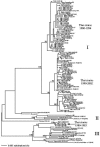Clade replacements in dengue virus serotypes 1 and 3 are associated with changing serotype prevalence
- PMID: 16306584
- PMCID: PMC1316048
- DOI: 10.1128/JVI.79.24.15123-15130.2005
Clade replacements in dengue virus serotypes 1 and 3 are associated with changing serotype prevalence
Abstract
The evolution of dengue virus (DENV) is characterized by phylogenetic trees that have a strong temporal structure punctuated by dramatic changes in clade frequency. To determine the cause of these large-scale phylogenetic patterns, we examined the evolutionary history of DENV serotype 1 (DENV-1) and DENV-3 in Thailand, where gene sequence and epidemiological data are relatively abundant over a 30-year period. We found evidence for the turnover of viral clades in both serotypes, most notably in DENV-1, where a major clade replacement event took place in genotype I during the mid-1990s. Further, when this clade replacement event was placed in the context of changes in serotype prevalence in Thailand, a striking pattern emerged; an increase in DENV-1 clade diversity was associated with an increase in the abundance of this serotype and a concomitant decrease in DENV-4 prevalence, while clade replacement was associated with a decline in DENV-1 prevalence and a rise of DENV-4. We postulate that intraserotypic genetic diversification proceeds at times of relative serotype abundance and that replacement events can result from differential susceptibility to cross-reactive immune responses.
Figures



Similar articles
-
The molecular epidemiology of dengue virus serotype 4 in Bangkok, Thailand.Virology. 2004 Nov 10;329(1):168-79. doi: 10.1016/j.virol.2004.08.003. Virology. 2004. PMID: 15476884
-
Molecular epidemiology of dengue virus serotypes 2 and 3 in Paraguay during 2001-2006: the association of viral clade introductions with shifting serotype dominance.Virus Res. 2008 Nov;137(2):266-70. doi: 10.1016/j.virusres.2008.07.011. Epub 2008 Aug 23. Virus Res. 2008. PMID: 18692099
-
Evolution of dengue virus in Mexico is characterized by frequent lineage replacement.Arch Virol. 2010 Sep;155(9):1401-12. doi: 10.1007/s00705-010-0721-1. Epub 2010 Jun 15. Arch Virol. 2010. PMID: 20549264
-
Dengue viruses circulating in Indonesia: A systematic review and phylogenetic analysis of data from five decades.Rev Med Virol. 2019 Jul;29(4):e2037. doi: 10.1002/rmv.2037. Epub 2019 May 16. Rev Med Virol. 2019. PMID: 31099110
-
Unraveling Dengue Virus Diversity in Asia: An Epidemiological Study through Genetic Sequences and Phylogenetic Analysis.Viruses. 2024 Jun 28;16(7):1046. doi: 10.3390/v16071046. Viruses. 2024. PMID: 39066210 Free PMC article. Review.
Cited by
-
Dengue incidence and length of viremia by RT-PCR in a prospective observational community contact cluster study from 2005-2009 in Indonesia.PLoS Negl Trop Dis. 2023 Feb 6;17(2):e0011104. doi: 10.1371/journal.pntd.0011104. eCollection 2023 Feb. PLoS Negl Trop Dis. 2023. PMID: 36745606 Free PMC article.
-
Dengue--quo tu et quo vadis?Viruses. 2011 Sep;3(9):1562-608. doi: 10.3390/v3091562. Epub 2011 Sep 1. Viruses. 2011. PMID: 21994796 Free PMC article. Review.
-
Dengue in the cooling off period of the COVID-19 epidemic in Brazil: from the shadows to the spotlight.Rev Inst Med Trop Sao Paulo. 2022 Jun 17;64:e44. doi: 10.1590/S1678-9946202264044. eCollection 2022. Rev Inst Med Trop Sao Paulo. 2022. PMID: 35730870 Free PMC article. No abstract available.
-
Molecular epidemiology of dengue viruses in southern China from 1978 to 2006.Virol J. 2011 Jun 26;8:322. doi: 10.1186/1743-422X-8-322. Virol J. 2011. PMID: 21703015 Free PMC article.
-
Molecular characterization and genotype shift of dengue virus strains between 2001 and 2014 in Guangzhou.Epidemiol Infect. 2017 Mar;145(4):760-765. doi: 10.1017/S0950268816002429. Epub 2016 Dec 6. Epidemiol Infect. 2017. PMID: 27919298 Free PMC article.
References
-
- A-Nuegoonpipat, A., A. Berlioz-Arthaud, V. Chow, T. Endy, K. Lowry, L. Q. Mai, T. U. Ninh, A. Pyke, M. Reid, J.-M. Reynes, S. T. S. Yun, H. M. Thu, S.-S. Wong, E. C. Holmes, and J. Aaskov. 2004. Sustained transmission of dengue virus type 1 in the Pacific due to repeated introduction of different Asian genotypes. Virology 329:505-512. - PubMed
-
- Bennett, S. N., E. C. Holmes, M. Chirivella, D. M. Rodriguez, M. Beltran, V. Vorndam, D. J. Gubler, and W. O. McMillan. 2003. Selection-driven evolution of emergent dengue virus. Mol. Biol. Evol. 20:1650-1658. - PubMed
-
- Bush, R. M., C. A. Bender, K. Subbarao, N. J. Cox, and W. M. Fitch. 1999. Predicting the evolution of human influenza A. Science 286:1921-1925. - PubMed
Publication types
MeSH terms
LinkOut - more resources
Full Text Sources
Other Literature Sources
Medical
Molecular Biology Databases

